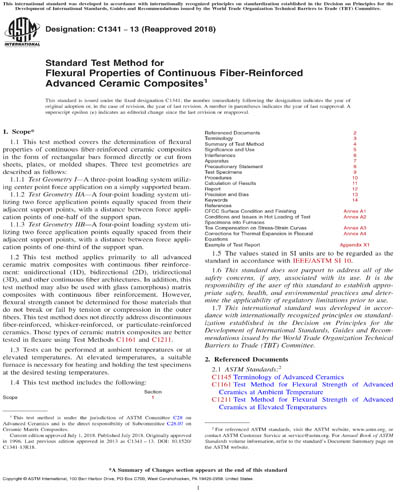Historical
ASTM C1341-13(2018)
Standard Test Method for Flexural Properties of Continuous Fiber-Reinforced Advanced Ceramic Composites
1.1 This test method covers the determination of flexural properties of continuous fiber-reinforced ceramic composites in the form of rectangular bars formed directly or cut from sheets, plates, or molded shapes. Three test geometries are described as follows:
1.1.1 Test Geometry I—A three-point loading system utilizing center point force application on a simply supported beam.
1.1.2 Test Geometry IIA—A four-point loading system utilizing two force application points equally spaced from their adjacent support points, with a distance between force application points of one-half of the support span.
1.1.3 Test Geometry IIB—A four-point loading system utilizing two force application points equally spaced from their adjacent support points, with a distance between force application points of one-third of the support span.
1.2 This test method applies primarily to all advanced ceramic matrix composites with continuous fiber reinforcement: unidirectional (1D), bidirectional (2D), tridirectional (3D), and other continuous fiber architectures. In addition, this test method may also be used with glass (amorphous) matrix composites with continuous fiber reinforcement. However, flexural strength cannot be determined for those materials that do not break or fail by tension or compression in the outer fibers. This test method does not directly address discontinuous fiber-reinforced, whisker-reinforced, or particulate-reinforced ceramics. Those types of ceramic matrix composites are better tested in flexure using Test Methods C1161 and C1211.
1.3 Tests can be performed at ambient temperatures or at elevated temperatures. At elevated temperatures, a suitable furnace is necessary for heating and holding the test specimens at the desired testing temperatures.
1.4 This test method includes the following:
1.5 The values stated in SI units are to be regarded as the standard in accordance with IEEE/ASTM SI 10.
1.6 This standard does not purport to address all of the safety concerns, if any, associated with its use. It is the responsibility of the user of this standard to establish appropriate safety, health, and environmental practices and determine the applicability of regulatory limitations prior to use.
1.7 This international standard was developed in accordance with internationally recognized principles on standardization established in the Decision on Principles for the Development of International Standards, Guides and Recommendations issued by the World Trade Organization Technical Barriers to Trade (TBT) Committee.
Content Provider
ASTM International [astm]






